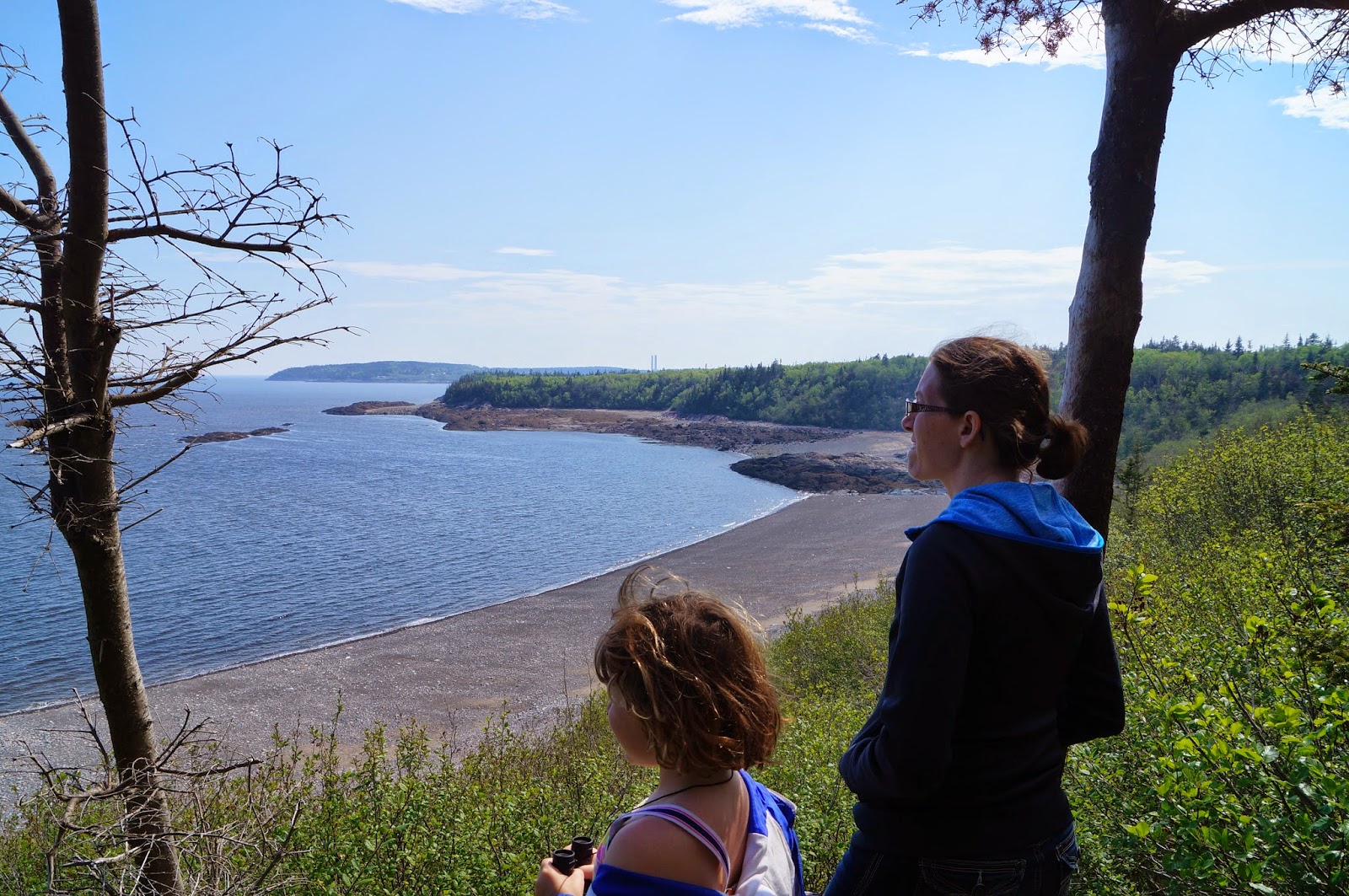The Bay of Fundy has the highest tides in the world; up to
50 feet in places. That’s taller than a four story building. At Saint John, where we spent a week, the tides
are closer to 25-35 feet. If you have a
two story house, go outside and look at it. Imagine that every 12 and a half
hours, or so, it was completely covered with water, and six hours after that the
water is all gone. That’s the tide here. It’s really impressive, and makes for
some spectacular sights up and down the coast.
Irving Nature Park, on the southern edge of Saint John, is a
great place to see the tides, and experience the Bay, without having to travel
far from the city. The park sits on a piece of land that juts out into the Bay
of Fundy, starting as the rolling hills (which seem to be a staple of New
Brunswick landscape) let out onto marshland and a gravel beach that slopes down
to the Bay. Past this flat area, the land rises again onto a spur of higher,
rocky ground that was left by the glaciers long, long ago.
At high tide, the spur would be mostly surrounded
by water – mudflats on one side, and the Bay on the other. We were there at low
tide, and so the mudflats were nearly drained, and the main gravel beach was very
deep. Lines of seaweed indicated that at
high tide the beach would hardly be there at all.
Multiple walking trails, as well as a one way road provide
access to nearly the entire spur, which is covered in dense forest, little
streamlets, and of course, views of the ocean. The main trail (Heron) which runs
parallel to the road (and shoreline) provides fantastic views of the mudflats
and bay, while the inner trails offer insight into the flora and fauna found
within the park. The road & Heron trail both let out onto multiple beaches.
 The beaches on the mudflat side were different from the beaches on the
Bay side – likely due to the difference in water flow (The mudflat side would
be subjected to much less pounding surf, and the beach stones and outcroppings were
rougher. They were also muddier!).
The beaches on the mudflat side were different from the beaches on the
Bay side – likely due to the difference in water flow (The mudflat side would
be subjected to much less pounding surf, and the beach stones and outcroppings were
rougher. They were also muddier!).
We took the truck around the road, stopping at the parking
areas, or the small pull outs to walk down to beaches, or explore sections of
the trail (inner and outer ones).
The kids eventually tired of walking, and so
the adults took it in turns – one to walk the trail, with or without a kid in
tow, while the other drove to the next parking area. This worked well, as we
each got to enjoy a part of the trail, without having everyone walk the long
loop (or keep going back for the truck).
The park seems to be a favourite with locals, as there were
many people out walking and jogging the trails. And, really, who wouldn't want
to frequent there, with such natural beauty and ever changing scenery to enjoy?
 Also, while in Saint John we went to see the Reversing
Falls. Reversing rapids, really, but it
is a neat place to see the influence of the massive tides. The Saint John River
lets out into the Bay of Fundy – half the time. The other half, the ocean water is surging back upstream, and the river
actually is being pushed backwards. We
took a look at both low and high tides.
Also, while in Saint John we went to see the Reversing
Falls. Reversing rapids, really, but it
is a neat place to see the influence of the massive tides. The Saint John River
lets out into the Bay of Fundy – half the time. The other half, the ocean water is surging back upstream, and the river
actually is being pushed backwards. We
took a look at both low and high tides.  At
low tide, the river was flowing to the ocean, and many whirlpools were visible
at the bend in the river, where the level of the river drops (visibly decreases
in altitude).
At
low tide, the river was flowing to the ocean, and many whirlpools were visible
at the bend in the river, where the level of the river drops (visibly decreases
in altitude).
A little further upstream,
kayakers were having fun in the rapids near a small set of islands.
The following day, at
high tide, indeed, the water was noticeably going the other way!
The big rocks
at the bend in the river were submerged (no whirlpools), and upstream where we
had watched the kayakers , there was no evidence of rapids around the islands.
The rocks, where the people had been fishing were at least 15 feet under
water.
Further beyond that, you could see
the rapids where the ocean water and river water met, by a change in water
color, and an ever moving line of white water.
Nature is awesome!












No comments:
Post a Comment